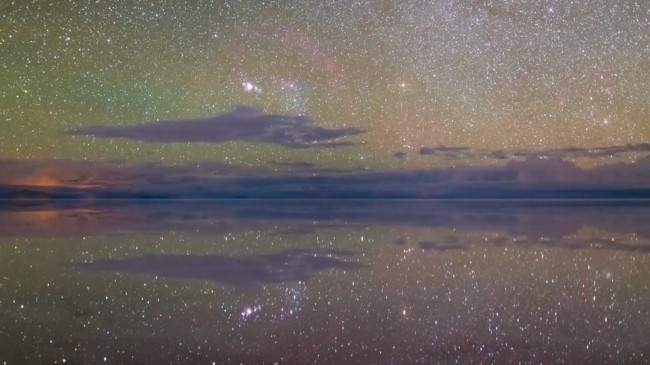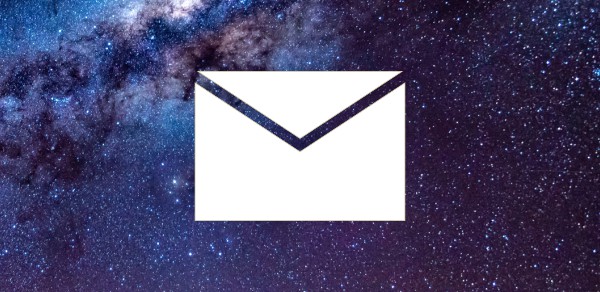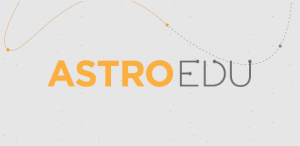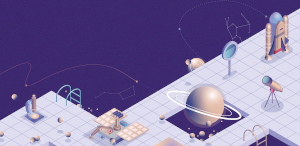This page describes a video Constellations from the World
Video caption:
Third place in the 2022 IAU OAE Astrophotography Contest, category Time lapses of celestial patterns.
This video tries to cover a huge variety of phenomena in the night sky from different locations — Iceland and China — and is designed like a theatre play, starring mother nature herself.
It starts with a blue twilight sky that dims and unveils the starry night sky on the stage with terrestrial clouds on a beautiful landscape. The impressive parts of the southern Milky Way between Scorpius and Crux, with the pointer stars Alpha and Beta Centaurus, are shown passing by majestically. The terrestrial clouds blur the stars and allow us to recognise their colours even more clearly.
The first act presents the starry sky in human culture. One scene shows the Pleiades rising over the top of a hill, while a human moves hastily with a flashlight below. At the very moment that the Pleiades rises behind the hill, the beam of the flashlight hits the camera. There is some humour in this remarkable scene referencing the human relationship to the rise of the Pleiades in cultural history.
The next scene shows The Big Dipper, Ursa Major, as a typical northern constellation, with an arch of aurora below it. The aurora evolves and moves but does not change much fundamentally. In northern human cultures, aurorae were often interpreted as the ghosts of ancestors, but this play does not spend any time on human beliefs, instead moving the view southwards in the subsequent scenes. First we see some stars rising shortly before sunrise. The lightcone of Zodiacal light appears in Gemini/Taurus and the horizon gets brighter. In the next scene, at about 1 minute and 13 seconds, we see Orion setting over water, so that the water surface mirrors the celestial scene. Some clouds crossing the image prove that the videos were really taken on our beautiful planet, and, since Orion’s shoulder and foot are seen to set almost simultaneously, this sequence must have been captured almost at the equator. In this area, the bright stars of Orion look like a huge butterfly, with Orion’s Belt forming the body, and the quadrilateral of four bright stars interpreted as the wings.
As in a real theatre, we now see a curtain before the next act of the heavenly play, an aurora curtain. The next act presents several bright stars in original scenes: the Chinese asterisms of The Tail (of the Azure Dragon), the Winnowing Basket and the Southern Dipper, which are seen in the modern constellations Scorpius and Sagittarius. The striking shape of Corona Borealis that has been recognised as an asterism in many cultures all over the globe, is also shown, as are some planets, the stars Vega and Deneb with adjacent areas, Altair, the Milky Way, and the characteristic W shape of Cassiopeia that has also been an asterism for many cultures on Earth.
The outro presents two more scenes with a smooth and silent night sky.
Scroll to captions in other languages
Video credit:
Stephanie Ye Ziyi/IAU OAE
DOI: 10.5281/zenodo.7425668
Related glossary terms:
Big Dipper
, Constellation
, Milky Way
, Orion
Categories:
Milky Way and Interstellar Medium
, Naked Eye Astronomy
Video license: Creative Commons Attribution 4.0 International (CC BY 4.0) Creative Commons Attribution 4.0 International (CC BY 4.0) icons
The media file captions presented on the OAE website were written, translated and reviewed by a collective effort from the OAE, the OAE Centers and Nodes, the OAE National Astronomy Education Coordinators (NAECs) and other volunteers. You can find a full list of credits for our translation project here. All media file captions are released under a Creative Commons CC BY-4.0 license and should be credited to "IAU OAE". The media files themselves may have different licenses (see above) and should be credited as listed above under "credit".
If you notice a factual error in this caption or an error in any of its translations then please get in touch.
Captions in Different Languages:
Video caption: Dritter Platz beim IAU OAE Astrofoto-Wettbewerb 2022, Kategorie Zeitraffer von Himmelsmustern.
Dieses Video versucht, eine Vielzahl von Phänomenen des Nachthimmels an verschiedenen Orten - Island und China - zu zeigen, und ist wie ein Theaterstück gestaltet, in dem Mutter Natur selbst die Hauptrolle spielt.
Es beginnt mit einem blauen Dämmerungshimmel, der sich verdunkelt und den sternenklaren Nachthimmel auf der Bühne zusammen mit irdischen Wolken über einer wunderschönen Landschaft enthüllt. Die beeindruckenden Teile der südlichen Milchstraße zwischen Scorpius und Crux, mit den Zeigersternen alpha und beta Centauri, ziehen majestätisch vorbei. Die irdischen Wolken verwischen die Sterne und lassen ihre Farben noch deutlicher erkennen.
Der erste Akt zeigt den Sternhimmel in der menschlichen Kultur. In einer Szene sieht man die Plejaden über einem Hügel aufgehen, während ein Mensch mit einer Taschenlampe eilig nach unten läuft. Genau in dem Moment, in dem die Plejaden hinter dem Hügel aufgehen, trifft der Strahl der Taschenlampe die Kamera. Diese bemerkenswerte Szene hat einen gewissen Humor und verweist auf die kulturgeschichtliche Beziehung der Menschen zum Aufgang der Plejaden.
Die nächste Szene zeigt den Großen Wagen (lat. Ursa Major) als typisches nördliches Sternbild mit einem Polarlichtbogen darunter. Die Aurora entwickelt sich und bewegt sich, ändert sich aber nicht grundlegend. In den nördlichen Kulturen der Menschen wurden Polarlichter oft als Geister der Vorfahren gedeutet, aber dieses Stück geht nicht auf den Glauben der Menschen ein, sondern verlagert den Blick in den folgenden Szenen nach Süden. Zunächst sehen wir einige Sterne, die kurz vor Sonnenaufgang aufgehen. Der Lichtkegel des Zodiakallichts erscheint in den Sternbildern Zwillinge und Stier und der Horizont wird heller. In der nächsten Szene, bei etwa 1 Minute und 13 Sekunden, sehen wir den Orion über dem Wasser untergehen, so dass die Wasseroberfläche die Himmelsszene spiegelt. Einige Wolken, die das Bild durchkreuzen, beweisen, dass die Videos tatsächlich auf unserem schönen Planeten aufgenommen wurden, und da Orions Schulter und Fuß fast gleichzeitig untergehen, muss diese Sequenz in der Nähe des Äquators aufgenommen worden sein. Dort sehen die hellen Sterne des Orion wie ein riesiger Schmetterling aus, wobei der Gürtel des Orion den Körper bildet und das Viereck aus vier hellen Sternen als Flügel interpretiert wird.
Wie in einem richtigen Theater sehen wir nun einen Vorhang vor dem nächsten Akt des himmlischen Schauspiels: einen Polarlicht-Vorhang. Der nächste Akt zeigt mehrere helle Sterne am Original-Schauplatz: die chinesischen Sterngruppen des Schwanzes (des Blauen Drachens), des Getreidekorbs und der Südlichen Schöpfkelle, die in den modernen Sternbildern Skorpion und Schütze zu sehen sind. Die auffällige Form der Corona Borealis, die in vielen Kulturen auf der ganzen Welt als Sternbild anerkannt ist, wird ebenfalls gezeigt, ebenso wie einige Planeten, die Sterne Wega und Deneb mit angrenzenden Bereichen, Altair, die Milchstraße und die charakteristische W-Form der Kassiopeia, die für viele Kulturen auf der Erde ebenfalls ein Sternbild ist.
Das Outro zeigt zwei weitere Szenen mit einem ruhigen und stillen Nachthimmel.
Video credit: Stephanie Ye Ziyi/IAU OAE
Related glossary terms: Großer Wagen , Milchstraße , Orion , Sternbild Caption translation status: Not yet approved by a reviewer
Caption translators: Carolin Liefke
Video caption: Terzo posto al concorso di astrofotografia IAU OAE 2022, categoria Time lapses of celestial patterns.
Questo video copre un'enorme varietà di fenomeni del cielo notturno da diverse località - Islanda e Cina - ed è concepito come una rappresentazione teatrale, con protagonista Madre Natura stessa.
Inizia con un cielo blu crepuscolare che si oscura e svela sul palcoscenico la notte stellata con qualche nuvola su un bellissimo paesaggio. Le impressionanti parti della Via Lattea meridionale tra Scorpius e Crux, con le stelle Alpha e Beta Centaurus, si vedono passare maestosamente. Le nuvole offuscano le stelle e ci permettono di riconoscere i loro colori ancora più chiaramente.
Il primo atto presenta il cielo stellato nella cultura umana. Una scena mostra le Pleiadi che sorgono sulla cima di una collina, mentre un uomo si muove con una torcia elettrica in basso. Nel momento stesso in cui le Pleiadi sorgono dietro la collina, il raggio della torcia colpisce la telecamera. In questa straordinaria scena c'è un certo umorismo che fa riferimento al rapporto dell'uomo con il sorgere delle Pleiadi nella storia culturale.
La scena successiva mostra il Grande Carro, l'Orsa Maggiore, come una tipica costellazione boreale, con un arco di aurora sotto di essa. L'aurora si evolve e si muove, ma non cambia in modo sostanziale. Nelle culture umane settentrionali, le aurore erano spesso interpretate come i fantasmi degli antenati, ma questo spettacolo non dedica tempo alle credenze umane, spostando invece lo sguardo verso sud nelle scene successive. Per prima cosa vediamo sorgere alcune stelle poco prima dell'alba. Il cono di luce zodiacale appare nei Gemelli/Toro e l'orizzonte diventa più luminoso. Nella scena successiva, a circa 1 minuto e 13 secondi, vediamo Orione tramontare sull'acqua, che fa da specchio alla scena celeste. Alcune nuvole che attraversano l'immagine dimostrano che i video sono stati girati davvero sul nostro bel pianeta e, dal momento che la spalla e il piede di Orione si vedono tramontare quasi contemporaneamente, questa sequenza deve essere stata catturata quasi all'equatore. In quest'area, le stelle luminose di Orione sembrano un'enorme farfalla, con la Cintura di Orione a formare il corpo e il quadrilatero di quattro stelle luminose interpretato come le ali.
Come in un vero teatro, un sipario di aurora introduce il prossimo atto. Ecco quindi diverse stelle luminose in scene originali: gli asterismi cinesi della Coda (del Drago Azzurro), del Cestello della Mietitura e del Southern Dipper, che si vedono nelle moderne costellazioni dello Scorpione e del Sagittario. Ma anche la suggestiva forma della Corona Boreale, riconosciuta come asterismo da molte culture in tutto il mondo, alcuni pianeti, le stelle Vega e Deneb con le aree adiacenti, Altair, la Via Lattea e la caratteristica forma a W di Cassiopea, anch'essa asterismo per molte culture sulla Terra.
Infine nella conclusione, altre due scene con un silenzioso cielo notturno
Video credit: Stephanie Ye Ziyi/IAU OAE
Related glossary terms: Costellazione , Grande Carro , Orione , Via Lattea Caption translation status: Approved by a reviewer
Caption translators: Valentina La Parola
Caption reviewers: Rodolfo Canestrari
Video caption: 2022 年国际天文学联合会 OAE 天体摄影比赛第三名,类别:天体的时间流逝。
本视频以自然为舞台主角,采用戏剧化结构,呈现冰岛与中国两地夜空的万千气象。
序幕由暮色蓝调渐暗展开,陆地云层为幕,壮美地貌为景,揭晓星空舞台。南天银河最摄人心魄的段落——天蝎座(Scorpius)与南十字座(Crux)之间,伴以半人马座α、β星(Alpha/Beta Centauri)这对"指极星",如王者巡游般庄严划过天际。地面流云轻抚星光,反令恒星的色彩在朦胧中愈发澄明。
第一幕演绎人类文化中的星空意象。当昴星团(Pleiades)自山巅升起时,下方人影持电筒匆匆掠过。恰在昴宿跃出山脊的瞬间,电筒光束直射镜头——这精妙设计以幽默笔触,暗合文明史上人类与"昴宿初升"的深刻羁绊。
随后镜头转向北天经典星座——大熊座(Ursa Major)及其北斗七星,下方极光如拱门舞动。虽形态流转不息,本质却亘古如初。尽管北极文化常将极光视为先祖魂灵,本剧却未着墨人类信仰,径自将视野南移。新场景始于日出前的星辰初升,双子座/金牛座(Gemini/Taurus)区域黄道光锥显现,地平线渐染晨曦。约1分13秒处,猎户座(Orion)西沉于水面,天光云影共徘徊。流云过境印证着地球实景拍摄,而猎户肩足近乎同步沉没的奇观,暗示拍摄地近赤道——在此纬度,猎户亮星恰似巨蝶展翅:三星腰带为躯,四星四边形化翼。
首先,我们看到一些星星在日出前不久升起。黄道十二宫的光锥出现在双子座/金牛座,地平线变得更加明亮。在下一个场景中,大约 1 分 13 秒时,我们看到猎户座落在水面上,因此水面与天体景象相映成趣。一些云层穿过画面,证明这些视频确实是在我们美丽的星球上拍摄的,而且由于猎户座的肩部和脚部几乎同时落下,这组视频一定是在赤道附近拍摄的。在这一区域,猎户座的亮星看起来就像一只巨大的蝴蝶,猎户座腰带构成了蝴蝶的身体,而四颗亮星组成的四边形则被解释为蝴蝶的翅膀。
如真实剧院般,极光幕帘为"天宇戏剧"开启新章。此幕聚焦独特文化星象:既有中国星官体系中的苍龙之尾、箕宿、南斗(对应现代天蝎座与人马座区域),亦展现在全球多文明中被尊为星群的北冕座(Corona Borealis)冠冕轮廓。行星、织女(Vega)、天津四(Deneb)及其周边区域、牛郎(Altair)、银河,以及被地球诸多文明视为星群的仙后座(Cassiopeia)W形标志相继登场。
终章以两幕宁谧星空作结,天地归于大寂。
Video credit: Stephanie Ye Ziyi/IAU OAE
Related glossary terms: 北斗七星 , 星座 , 猎户座 , 银河系 Caption translation status: Not yet approved by a reviewer
Caption translators: Lin Shijie
Video caption: 2022 年國際天文學聯合會 OAE 天體攝影比賽第三名,類別:天體的時間流逝。
本視頻以自然為舞臺主角,採用戲劇化結構,呈現冰島與中國兩地夜空的萬千氣象。
序幕由暮色藍調漸暗展開,陸地雲層為幕,壯美地貌為景,揭曉星空舞臺。南天銀河最攝人心魄的段落——天蠍座(Scorpius)與南十字座(Crux)之間,伴以半人馬座α、β星(Alpha/Beta Centauri)這對"指極星",如王者巡遊般莊嚴劃過天際。地面流雲輕撫星光,反令恆星的色彩在朦朧中愈發澄明。
第一幕演繹人類文化中的星空意象。當昴星團(Pleiades)自山巔升起時,下方人影持電筒匆匆掠過。恰在昴宿躍出山脊的瞬間,電筒光束直射鏡頭——這精妙設計以幽默筆觸,暗合文明史上人類與"昴宿初升"的深刻羈絆。
隨後鏡頭轉向北天經典星座——大熊座(Ursa Major)及其北斗七星,下方極光如拱門舞動。雖形態流轉不息,本質卻亙古如初。儘管北極文化常將極光視為先祖魂靈,本劇卻未著墨人類信仰,徑自將視野南移。新場景始於日出前的星辰初升,雙子座/金牛座(Gemini/Taurus)區域黃道光錐顯現,地平線漸染晨曦。約1分13秒處,獵戶座(Orion)西沉於水面,天光雲影共徘徊。流雲過境印證著地球實景拍攝,而獵戶肩足近乎同步沉沒的奇觀,暗示拍攝地近赤道——在此緯度,獵戶亮星恰似巨蝶展翅:三星腰帶為軀,四星四邊形化翼。
首先,我們看到一些星星在日出前不久升起。黃道十二宮的光錐出現在雙子座/金牛座,地平線變得更加明亮。在下一個場景中,大約 1 分 13 秒時,我們看到獵戶座落在水面上,因此水面與天體景象相映成趣。一些雲層穿過畫面,證明這些視頻確實是在我們美麗的星球上拍攝的,而且由於獵戶座的肩部和腳部幾乎同時落下,這組視頻一定是在赤道附近拍攝的。在這一區域,獵戶座的亮星看起來就像一隻巨大的蝴蝶,獵戶座腰帶構成了蝴蝶的身體,而四顆亮星組成的四邊形則被解釋為蝴蝶的翅膀。
如真實劇院般,極光幕簾為"天宇戲劇"開啟新章。此幕聚焦獨特文化星象:既有中國星官體系中的蒼龍之尾、箕宿、南斗(對應現代天蠍座與人馬座區域),亦展現在全球多文明中被尊為星群的北冕座(Corona Borealis)冠冕輪廓。行星、織女(Vega)、天津四(Deneb)及其周邊區域、牛郎(Altair)、銀河,以及被地球諸多文明視為星群的仙後座(Cassiopeia)W形標誌相繼登場。
終章以兩幕寧謐星空作結,天地歸於大寂。
Video credit: Stephanie Ye Ziyi/IAU OAE
Related glossary terms: 北斗七星 , 星座 , 獵戶座 , 銀河系 Caption translation status: Not yet approved by a reviewer
Caption translators: An automated transliteration from the simplified Chinese translation by - Lin Shijie









